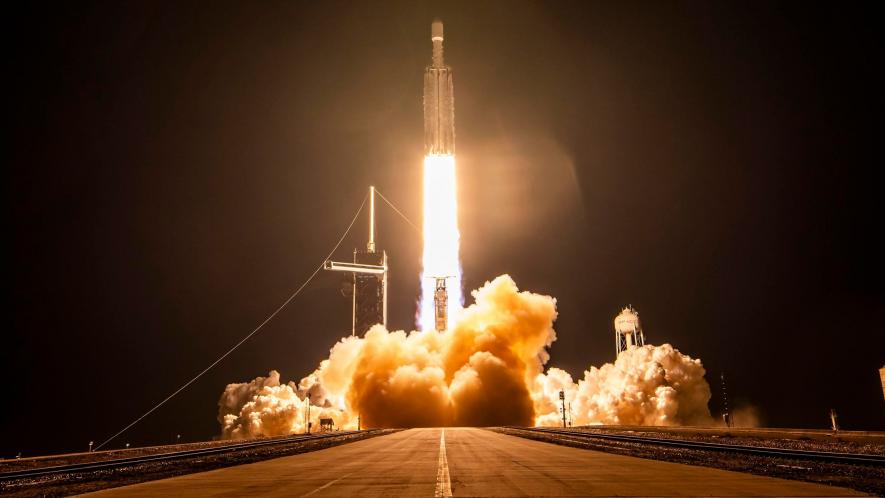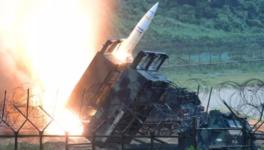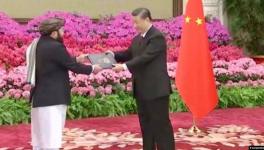US Secretive X-37B Military Spacecraft Takes off From on Musk’s Space-X

Image Courtesy: Twitter/@SpaceX
The highly secretive X-37B military spacecraft of the US Space Force took off on December 28, from NASA’s Kennedy Space Centre in Cape Canaveral, Florida, on its seventh and hitherto most extensive test. The spacecraft was launched aboard a Falcon Heavy rocket of Elon Musk’s Space-X, the first time this world’s most powerful rocket has been used to launch the X-37B, indicating that it is carrying a heavier payload than previous test flights.
Very little is known in the public domain about this spacecraft, the intended missions it has been designed and is being tested for, or what instruments, systems or indeed weapons it may now or in the future carry.
Some insights, although admittedly speculative, may be gleaned by piecing together snippets of information gathered from writings by reporters or space systems observers including on earlier test flights. One thing is, however clear, namely that the X-37B is a major space-based system around which a sophisticated and relatively novel military programme is being fashioned by the US.
It is not surprising that such space-based systems have become yet another theatre of rivalry between the US and China. It can hardly be considered a coincidence that China also conducted a test-flight of a probably similar and even more secretive spacecraft within a few days of the X-37B test flight.
BRIEF HISTORY OF X-37B
The X-37 series of spacecraft designed and manufactured by Boeing also carries the historical term Orbital Test Vehicle (OTV). It began as a NASA project in 1999 and was transferred to the US department of defence in 2004. It was managed by the US Air Force till 2019 after which it was taken under the then-newly established US space force set up during the Trump administration and till now the world’s only such separate space-based military force.
However, there is still considerable overlap given historical contributions to design, planning, envisaged operations and on-board systems, so the X-37B still remains a US air force platform despite currently being launched by the US space force which will take over its future operational command.
The X-37B has evolved through many avatars and design concepts by NASA and the USAF with Boeing as the main contractor. These variants range from the early X-40 to the X-37A and finally the X-37B, from an essentially glide vehicle dropped from other aircraft or even from the space shuttle to a full-fledged space vehicle designed and with capabilities for prolonged orbital flight and space-based operations.
As readers would doubtless recognise, the X-37B bears a strong resemblance to the space shuttle, but is about a quarter the size, and weighs around 5,000kg at take-off. This makes it the smallest and lightest robotic spacecraft, and the third ever developed after the Soviet Buran and the US Space Shuttle, which had developed the capability but had never demonstrated it. While it is fully reusable, like the shuttle, it is unscrewed and fully autonomous once launched by a suitable rocket. Like the shuttle, it is launched vertically and lands horizontally on a runway, but autonomously.
Its series of test flights have seen the capabilities, functions and performance of the X-37 go through several stages of upgradation. While it first flew in 2006 as a drop test, its first orbital mission was launched by an Atlas V rocket in April 2010, returning to land in December that year. Subsequent flights extended the duration, probably the altitude as well, and certainly the payload, requiring more powerful launchers. Its fifth test mission was launched aboard a Falcon 9 rocket and achieved a record-breaking 780 days in orbit.
The sixth mission achieved an even longer 908 days in orbit, this time with an add-on payload-carrier at the tail end. The current seventh test flight, launched aboard a falcon heavy rocket, is expected to attempt new orbital regimes at possibly higher altitudes, and conduct various experiments about which very few details have emerged.
TECHNOLOGIES AND MISSION
Most details about the missions and about the technologies and payloads aboard the X-37B spacecraft on its seven tests flights so far have been a closely guarded secret. So much so, that the live webcast of the launch, in both the latest and the previous one, was terminated after a minute or so into the flight, so that the exact trajectory, eventual altitude and orbital path would not be revealed immediately, although determined countries and space agencies could always determine them subsequently.
Military spokespersons even stated that while in elliptical orbit, special thruster firings at perigee, when the craft is closest to earth and the atmosphere is thin, could alter the orbital regime, again making close tracking of the spacecraft that much more difficult, and providing a narrow window to conduct secret experiments.
Some information on a few of the experiments on board are, however, known at least to a certain limited extent.
The US air force has emphasised different aspects of reusability and autonomy, especially conducting various experiments using hardware that could be brought back at the end of test flights. Avionics, flight systems, guidance and navigation, propulsion and re-entry system, and protection from extreme heat and radiation are some other aspects being tested.
One of the interesting experiments involves capturing solar energy through high-efficiency solar cells, convert the solar energy to radio-frequency, and then beam the energy back to earth at precise locations. This could facilitate the provision of uninterrupted power to expeditionary forces at remote forward locations where other energy resources are not available.
This Space Solar Power Incremental Demonstration and Research (SSPIDR) Project of the USAF Research Lab has been described by USAF spokespersons as one among several ‘big ideas pipeline” of game-changing technologies being developed by the USAF which could have military as well as civilian applications. Defence major Northrop Grumman has been awarded a $100 million contract to conduct experiments under the SSPIDR Project.
HALL THRUSTERS
One other interesting experiment on board the X-37B deserves note. USAF spokespersons have stated that a Hall-effect Thruster (HET) is being tested for Aerojet Rocketdyne, the propulsion systems specialist. To clarify, the Hall Thrusters are not a new innovation and have been in use for several decades by several space-faring nations including India.
Put simply, Hall Thrusters do not use combustion or burning of propellants or rocket fuel to provide thrust to a rocket. In combustion-type rocket engines, thrust or propulsion force is generated using Newton’s third law of motion, i.e, that force in one direction produces an equal force in the opposite direction, and the law of conservation of momentum, i.e, that momentum being the product of mass and velocity will remain the same, so if combusted propellant is expelled rearward from a rocket at high speed, the reduction in mass will generate proportional velocity to propel the rocket vehicle forward.
In a Hall Thruster, named after American physicist Edwin Hall, propellants are not burned but the material is converted to electrically charged particles, accelerated using electrical power and expelled rearwards, generating power in the opposite direction.
Of course, the power thus generated is tiny compared with conventional combustion-based engines. Therefore, such thrusters are used by spacecraft or satellites for manoeuvres of very small magnitude, such as minor trajectory adjustments and for station-keeping, that is ensure that orbital regimes or positions are retained at the original design paths or locations, and not allowed to drift due to various unpredictable forces at play in space.
The former Soviet Union is widely considered to have had the maximum success with Hall Thrusters. Over 200 Hall Thrusters with variants have been used in Russia and the former Soviet Union, with zero failures reported. Indeed, operational Thrusters entered the US space programme from the erstwhile Soviet Union in the early 1990s, like many other space-related technologies including primary rocket engines.
China, too, widely uses them in a highly classified programme, and has recorded more than 8000 hours of continuous operation on the Tiangong space station and its crew module, the first human-rated application of the Hall Thrusters. ISRO too has a well-deserved reputation in developing and using Hall Thrusters for different applications as described above.
Undoubtedly, the X-37B test flights are being used to experiment with higher-efficiency Hall Thrusters, since getting the most out of the rare materials used as propellants has always been a challenge.
CHINA RIVAL EFFORTS
In realms of high technology, especially in military applications, the US-China rivalry in space is gaining momentum by the day. It, therefore, comes as no surprise that China launched its own exceedingly secretive reusable and autonomous spacecraft on December 14, 2023, just two weeks before the launch of the US’s X-37B. In fact, both launch dates may have coincided had it not been for a series of mostly weather-related delays in the X-37B launch.
This is believed to be the third test flight since 2020 of the Chinese robotic spacecraft called Shenlong, or Divine Dragon. The previous flight was in August 2022 and the raft returned after 276 days in orbit. No photograph of the Chinese spacecraft has yet emerged in public.
No mission details of the Shenlong spacecraft are available in the public domain. Some US-based amateur spacecraft-trackers have put out details of several small objects that have been placed in different orbits by the spacecraft. They have further reported that some of these objects have been observed to intermittently be transmitting signals similar to those observed in earlier Shenlong launches and unique to them.
Some other orbiting objects seem to be transmitting “placeholder” signals i.e, merely to indicate their continuing operation and location. These small objects could be small test satellites or meant to observe and track the Shenlong craft.
For all the lack of knowledge about these robotic spacecraft, their intent and eventual application may well be anticipated. They may start with domain awareness in space, that is surveillance of other commercial, state-operated or military space-based objects, and also surveillance of designated locations or objects on earth, as well as providing linking, communications, networking and control of other space-based or terrestrial equipment.
But any orbiting craft that can do all this, can easily transition to weaponised applications that can attack objects it has been tracking. It did not take long for surveillance drone aircraft to become attack drones. So too, it will not take long for these robotic spacecraft to also become weaponised and threaten other space-based or terrestrial systems.
The writer is with the Delhi Science Forum and All India People’s Science Network. The views are personal.
Get the latest reports & analysis with people's perspective on Protests, movements & deep analytical videos, discussions of the current affairs in your Telegram app. Subscribe to NewsClick's Telegram channel & get Real-Time updates on stories, as they get published on our website.
























